explain the process of conduction of water in plants with diagran
All plants need water, minerals and food. There is a system present in plants called transport system to distribute these substances throughout the body. Flowering plants have a very well developed system to transport these substances, this system is called vascular system. Vascular system contains two types of tissues, xylem and phloem.
Xylem distributes water and phloem distributes food throughout the plants body. Plants need water for photosynthesis, transpiration, transportation and for mechanical function. Minerals are also required by the plants as salts or as ions. Water is absorbed by the roots, [Fig. 2.1 (a)] for this, roots provide huge surface area, they contain cell sap of higher concentration than the surrounding water and root hair have thin walls. The vascular tissues are present in plant body from the tip of roots up to the leaves, xylem and phloem also joined end to end and form long tubes and phloem cells form long tubes for their functions.
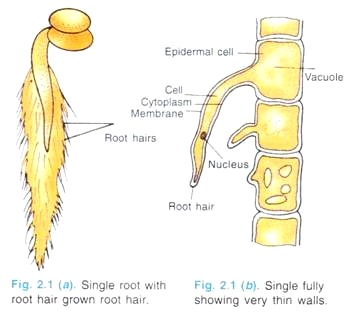
Absorption of Water:
Water enters the plant body through root hair, by the process of osmosis. Osmosis is a process by which the molecules of solvent (water) move from a region of low concentration to a region of high concentration through a semi permeable membrane.
Demonstration of Osmosis using Potato Osmoscope:
Scoop a cavity in a large sized peeled potato, now slice the bottom to make the base flat. Now this potato is kept in water containing petri-dish, in such a way that half potato is immersed in water. Now fill the potato cavity with 25% sucrose solution and mark its level by inserting a pin (As show in diagram) Fig. 2.2.
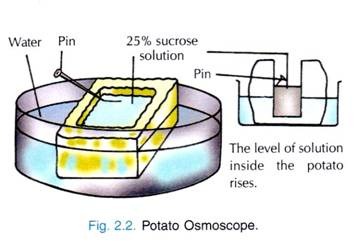
Now after some time, we observe that liquid in cavity rises, because, the water (pure solvent) has moved through the potato walls and accumulated inside the cavity, when concentration of water molecules (solvent) was lower (due to the presence of sucrose molecules). This experiment proves that osmosis has taken place. Potato wall acts as semi permeable membrane but if we boil the potato the membrane loses its semipermeable nature and only diffusion will take place.
Diffusion is the movement of molecules of a substance from a region of higher concentration to a region of lower concentration:
Demonstration of Osmosis by using thistle funnel:
Close the mouth of thistle funnel by parchment paper and now fill thistle funnel by sugar solution and suspend the thistle funnel in beaker containing water. (Fig. 2.3a) After one or two hours level of solution in the stem of thistle funnel rises due to the movement of water molecules in thistle funnel through parchment paper, which act as semi-permeable membrane.

This proves that the water molecules move from low concentration (from beaker) to the high concentration (inside thistle funnel) say osmosis. (Fig. 2.3 b).

[Fig. 2.1 (b)] root hair cells have high concentration or osmotic pressure, as compared to surrounding water due to this water diffuses from outside into the root cells. In roots most absorption takes place by root hair zone having numerous root hairs. The walls of root hair are very thin and permeable.
The absorption of water by the solid particles of a substance in dry or semi-dry condition with forming a solution is called imbibition. Absorption also takes place by diffusion and osmosis. Through these processes molecules of substances move from higher concentration to lower concentration. Water molecules also move through semi-permeable membrane from a dilute to concentrated solution.
Experiment to show absorption of water:
Put a young leafy plant in a water containing test tube (Fig. 2.4). Put some oil drops to prevent evaporation. Mark the level of water. After some time you will see that water level has gone down. It proves that water lost was absorbed by the roots.
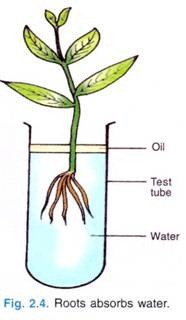
Conduction:
Vascular bundles in stem, roots, leaf veins forms an unbroken system of tubes which collectively perform a transport system (Fig. 2.5) throughout the entire plant body. Water and salts travel upwards through xylem tissues and food travels up and down directions through phloem tissues (Fig. 2.6 a & b).
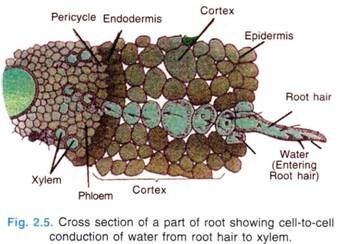
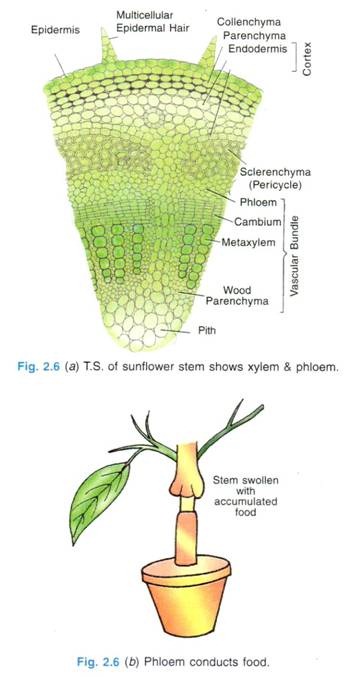
Conduction of water through xylem:
Cut two leafy shoots of balsam plant (Fig. 2.7) under water to prevent entry of any air bubble. Now by keeping lower end of shoot in water remove near about 2-3 cm outer ring (phloem) of stem, keeping the central part intact. In second shoot, remove the central part (xylem) of equal length. Now fix both the shoots in stands and observe, after two days we find that the leaves of first shoot remain turgid and stands normally, but in second twig leaves wilt and droop down, this experiment proves that water is conducted through xylem.
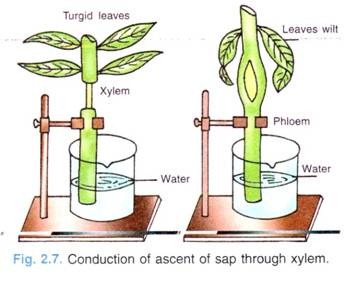
Conduction of food through phloem:
Cut a ring around the stem of a healthy plant deep enough to penetrate the phloem and cambium but not the xylem. It will be seen that sap starts oozing out from the farther cut-margin of the stem. After some weeks, it is seen that part of the stem above the ring has grown in diameter and below the ring the growth of stem is stopped and may die after some time, when food stored is finished. The leaves are healthy due to continuous supply of water through the xylem tissues.
hope it helps.....(y)


